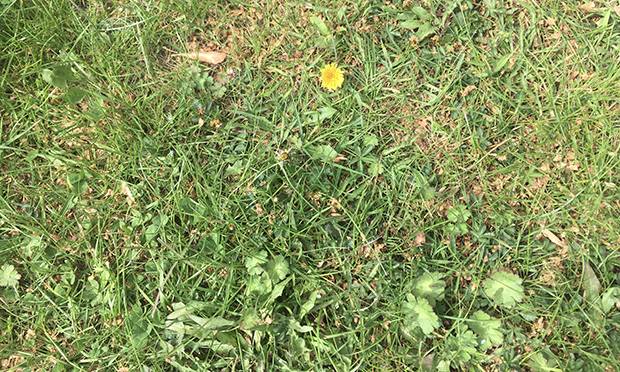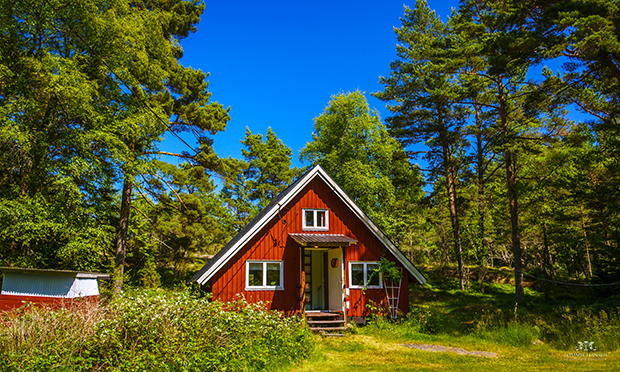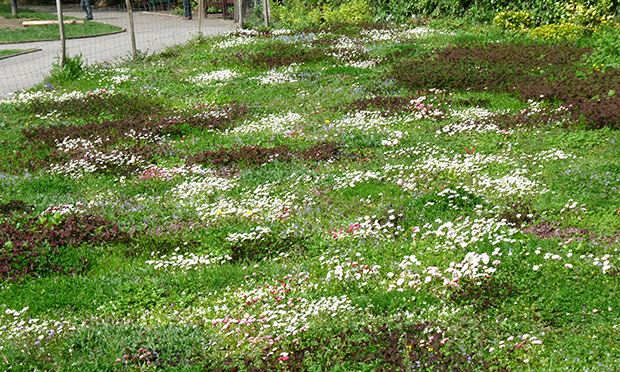The Citizen Gardener: No Mow May

My friend (let’s call him Walter) loves to mow; to bring order to an unruly piece of grass. He likes to cut it close and neatly, sharpen the edges and remove weeds. He likes a football pitch patterning (diamonds or stripes) and will do it over again if there is a wiggle or uneven patch.
I like to mow, too. I get great satisfaction in taming a wild bit of grass. This could be seen as a reflection of our approach to nature – that we must control it – or just a desire for order in a chaotic world.
Now is the time when we turn our attention to grass (if we have the space) but lawns are quite hard to create in our crowded gardens.
Grass is tough but it really doesn’t like shade, dogs, footballs being left forgotten on top of it for weeks or being danced on throughout lockdown, so London lawns often end up dusty, compacted and patchy – especially when there’s been little rain.
To get them looking good uses a lot of energy and water and in many cases our gardens just aren’t suitable for that pristine billiard-table look.
If you are trying to make your gardening practice more wildlife-friendly, completely crew-cut lawns are not friends to the natural environment. They tend to be one species of grass which is not allowed to complete its life cycle so is, in effect, sterile and useless to wildlife. So I’ve been looking at alternatives to the Wimbledon-like lawn and looking at Plantlife’s No Mow May campaign to get everyone (including councils) to put their mowers away for at least a month.
The RSPB has a good section of its website with advice for how to manage lawns in a more (in their case) bird-friendly way.
Lawns can be really good for wildlife of we do them a bit differently. They can provide seed for birds and habitat for the creatures that other birds like to eat.
Paths
For some years I’ve been visiting Sweden and in the countryside they tend to mow paths through grass and plants they let grow tall, so the swathes are like animal tracks winding through undergrowth. They allow the grass to live out its natural cycle to produce seed.

It’s very soothing to walk along these paths and hear the swish of moving plants alive with insects and other plants.
We don’t have the space they have in Sweden but can do this on a small scale by cutting paths through longer grass – or just leaving long patches in the corners.
Mow less
If you don’t want areas of long grass, just cutting a bit less often (note to editor’s wife) is beneficial. If you cut your grass too short, you are likely to get bald patches which become compacted and dried out. Longer grass keeps moisture in and provides shelter for beetles and egg-laying opportunities for insects.
You could leave the mower in the shed for the month or all summer and then just do one big cut in the autumn like a traditional hay meadow.
The long and short of it
Some short grass is important for birds such as blackbirds and thrushes to get at worms and for insect-eaters to forage among the roots.
The edges of paths cut short can be places for solitary bees to make nests and for butterflies to bask so a mixture of long and short is important.
Mix it up
Grass is a resilient plant (it tolerates being trampled and rolled on, shaved, littered, starved of nutrients and water). Every year it goes through a range of assaults from flooding to drought and it always comes back so it is useful to have in the garden. In fact, with the right conditions, it’s hard to get rid of and I am constantly battling with it at the allotment. I have given in and use it for paths between beds and have gradually allowed other plants to move in. There are many that are beneficial to wildlife and can still bear being walked on – like clover, daisies, dandelion and cranesbill. If you want a plant that will overcome grass, put yellow rattle in.
I satisfy my mowing urge with my grass paths but also allow patches of long grass to grow and go to seed. I love the scratch, creak and surprise of grasshoppers popping up when I walk past on a warm day. The more variety you can get into your lawn, the better.
Get rid of the grass completely
It is possible to get rid of the grass completely (or perhaps the parts of it that aren’t doing so well) and grow things that are still happy being cut (so you get your fix of getting order – as well as giving the smaller plants the light they need) but that you can leave it to flower as well.

Non-grass lawns or tapestry lawns are a new approach that replaces grass with more flowering plants – and include ones that have probably already tried to make an appearance in your lawn like daisies, buttercups, yarrow and clover but you can add things like creeping jenny, ajuga, potentilla, geraniums, campanula.
A range of plants can provide nature with nectar and habitat. Grassfreelawns.co.uk has advice about how to do create them. There’s even a book.
Growing a tapestry lawn or a meadow will take a lot more expert attention than a one-species lawn but I’d certainly like to have a go.
Another alternative to grass or paving is gravel. Beth Chatto (bethchatto.co.uk) created a dry/gravel garden in 1992 which is populated by drought-resistant plants. Her garden is near St Osyth, the driest part of the country with just 506.9mm a year of rainfall. London has an average of 557mm/year, which incidentally is less than Rome (799mm), Milan (920mm) or Monaco (733).
Chatto foresaw drier times to come and we are now experiencing long dry periods so it’s worth looking at plants that can survive in these conditions.
Gravel can get kicked around a bit so might be a bit messy but it’s lovely to see things arrive and thrive in such an unlikely habitat. In fact, the poorer the soil, the better for our native wildlife.
Have a look at eco-friendly garden expert John Little’s home in Essex to see what can bloom if given the chance (bit.ly/2RcSqWX). Not possible in our gardens which lack the light but do visit if you can.
Kate Poland is an award-winning community gardener and the UK’s first ever postcode gardener in E5. For more, head to cordwainersgrow.org.uk and friendsoftheearth.uk
